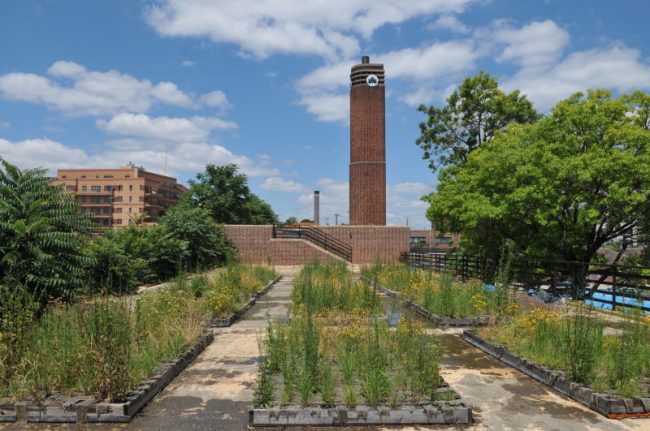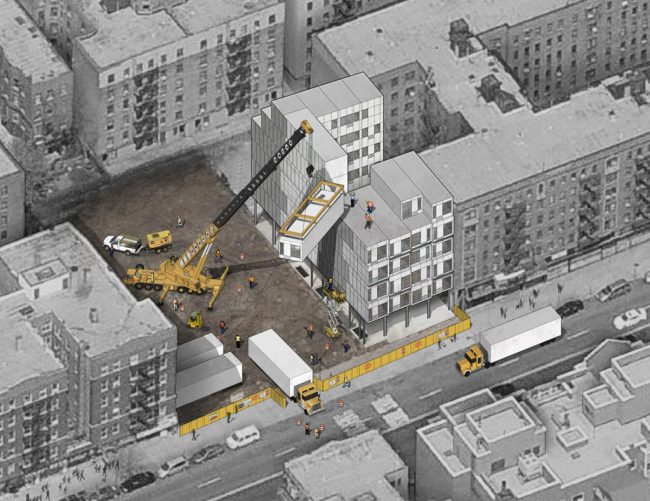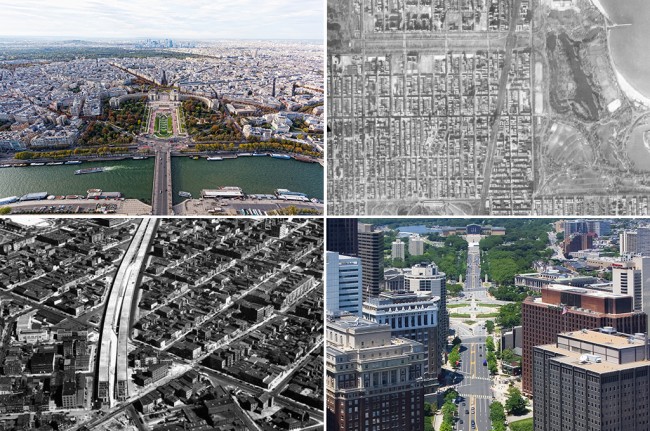
We are celebrating 15 years — and counting — of stories that are deeply researched and deeply felt, that build a historical record of what the city has been.
We are celebrating 15 years — and counting — of stories that are deeply researched and deeply felt, that build a historical record of what the city has been.

Green roof at the Lyons Recreation Center in Staten Island, one sample area in the study | Image via NYC Parks
ELEVATED BIODIVERSITY
Green roofs are often lauded for their cooling effect and runoff absorption, but a new study of green roofs across the five boroughs exhibits their important role as functioning habitats. An analysis of soil cores shows an average of 109 types of fungi per roof, only 54% of which were found in neighboring parks, a overlooked source of important biodiversity in the urban environment.
NYCHA REPAIRS
Residents in New York City Housing Authority’s 178,000 units may be moving closer to having their floor fixed or ceiling patched. The public housing authority announced Monday a new goal of cutting outstanding repair orders — currently at 350,000 and augmented by an average of 50,000 additional repair requests per week — to 100,000 by year-end, continuing a renewed effort by the City to clear a backlog that has left some residents waiting up to two years for carpentry work. NYCHA officials did, however, hedge their announcement with the likelihood that sequestration cuts might cost the authority $150 million, once again lowering the priority of maintenance and repairs.
THE BENEFITS OF MIXED-USE ZONING
Proponents of mixed-use planning have long touted the benefits of varying land uses in one area, especially that more “eyes on the street” creates a safer community. Now, a new study of crime rates across eight neighborhoods, some wholly commercial or residential and others mixed-use or going through zoning changes, gives this claim factual evidence. Neighborhoods in which a zoning change introduced a new land use into a previous single use area — like new residential development in an previously commercial district, adding more people to the neighborhood at all times of the day and enhancing sense of ownership for the area — experienced drops in crime in addition to the increased vibrancy that comes with diversity of use. John MacDonald, the lead on the study, says the results should add thinking about land use to the crime prevention toolkit.
UNDERGROUND LIBRARY
Charged with finding new ways to lure New Yorkers to the the 87 branches of the New York Public Library throughout Manhattan, the Bronx, and Staten Island (Queens and Brooklyn being served by their own systems), three students at the Miami Ad School developed Underground Library. The concept utilizes Near-Field Communication (NFC) technology embedded in a subway poster to allows straphangers to swipe a book on the poster with a smartphone and read the first ten pages, just enough to occupy most commutes and get you hooked, for free. Upon surfacing, users can find the closest library branch to check out the full text.
TRANSIT RIDERSHIP UP
According to a new report by the American Public Transportation Association (APTA), transit ridership nationwide topped 10.5 billion trips in 2012, the second highest annual ridership total since 1957 and 157 million trips more than 2011. The increase would have been higher had it not been for an estimated 74 million trips lost due to transit blackouts following Hurricane Sandy. APTA recorded an increase in ridership across transit platforms, regions, and city sizes. In New York City, the MTA hopes to improve the transit experience with the expansion of two projects aimed at providing users more real-time information: at least 77 additional “On the Go” kiosks will be added to stations throughout the city in the next few years and BusTime, its bus arrival tracking system, will be extended to all buses by April 2014.

Installation mock-up for The Stack | Image via Gluck+
MODULAR MOMENTUM
Once scorned for its associations with mobile homes, modular construction is becoming increasingly common in New York, most recently with The Stack in Inwood. By constructing most of the building in stackable units off-site, the technique allows simultaneous on-site ground preparation and off-site building construction, while providing a more controlled construction environment in a factory that reduces material waste, allows higher construction quality, and eliminates weather-related delays. The developers of the building note the technique’s time savings (nine months of construction versus sixteen to eighteen) and cost savings (10 to 20% less expensive). A shift toward modular construction would mark a shake-up of the construction industry: workers at facilities that construct the units, though often unionized, typically take home lower wages than on-site workers.
NYC GROWING
For the first time since the post-war 1940s, more people moved to the Bronx in the year ending July 1, 2012, than left. The Bronx’s mild growth is largely attributed to its improved and affordable housing stock, though some transplants have marked its sense of community as the often-maligned borough’s true draw. The trend is mirrored across the city as a whole, which, for the first time since 1950, added more residents from migration than it lost — a shift that has contributed to an overall population increase of 161,564 people since 2010, nearly as many as the city gained from 2000 to 2010. One hotspot, Downtown Brooklyn, is set to continue a current wave of development in the next few years that would add over 4,700 new apartment units in 14 new developments.

Net-zero lifeguard stations for city beaches by Garrison Architects | Images by Garrison Architects via FastCo.Exist
SANDY UPDATES
Governor Cuomo’s $400 million buyout plan for residents in New York’s hardest hit areas seems to be catching on as at least five communities on Staten Island have begun organizing to take advantage of the proposal that could give residents up to a 25% bonus on top of the pre-Sandy value of their home for moving out as a community. At an average of $400,000 per buyout, the $400 million allocated to the program can only afford to offer 1,000 buyouts, so competition is expected. Despite a majority of homeowners in some neighborhoods committed to taking advantage of the buyouts, 100% participation is unlikely, raising concerns over what will happen to the residents and community that stay behind.
The US Army Corps of Engineers announced the federal government’s commitment to fund, in full, the $1 billion restoration of four areas along the Brooklyn, Queens, and Long Island shorelines, a step up from the 65% funding commitment made under the Sandy relief package that passed Congress in late January. The project will include beach replenishment and dune protection enhancement for Coney Island, Rockaway Beach, Long Beach Island, and Fire Island.
New York City beaches at Coney Island, Staten Island, and the Rockaways will also receive new lifeguard stations, comfort stations, and beach offices designed by Garrison Architects to replace those destroyed by Sandy. The new structures will be elevated above the new FEMA storm surge levels and aspire to net-zero energy consumption through the use of photovoltaics, solar water heating, and skylight ventilators. Jim Garrison, the principal of the firm, hopes the modular nature of the buildings will also serve as inspiration for the use of modular design in future disaster response.

Clockwise from top left: Paris, Chicago, Philadelphia, New York | Images by Shchipkova Elena via Shutterstock, Dale Winling, NYCDPR via Architect’s Newspaper, and 7505811966 via Shutterstock
EVENTS AND STUFF TO DO
THE PLANNING GAME
Alexander Garvin, an architect and urban planner, will present his book The Planning Game: Lessons from Great Cities on March 19th at 6:30pm at the Skyscraper Museum. The book illustrates the many levels of city-making through the lens of the historical evolution of Paris, Chicago, Philadelphia, and New York at the hands of their respective master builders. RSVP with the name of the program to programs@skyscraper.org.
AN EVENING WITH NARRATIVELY
On Sunday, March 17th, join UnionDocs for a showcase of some of the compelling multimedia material produced by our friends at Narratively, an online platform devoted to “slow journalism” that privileges long-form, in-depth storytelling of New York’s untold stories. Narratively’s founders, editors, and contributors will be on hand to discuss five works documenting a “hospital for clocks,” gentrification in Crown Heights, and more.
LAND ETHIC FOR THE URBAN ERA
In the last lecture of his series “Cities in Crisis: Ecological Transformations,” Dr. Steward Pickett, past president of the Ecological Society of America and a plant ecologist with the Cary Institute of Ecosystem Studies, will discuss the possible environmental advantages of cities and their incorporation into ethical urban thinking. Head over to the Great Hall at Cooper Union at 6:30pm on Monday, March 18 for the talk.
The Roundup keeps you up to date with topics we’ve featured and other things we think are worth knowing about.
The views expressed here are those of the authors only and do not reflect the position of The Architectural League of New York.